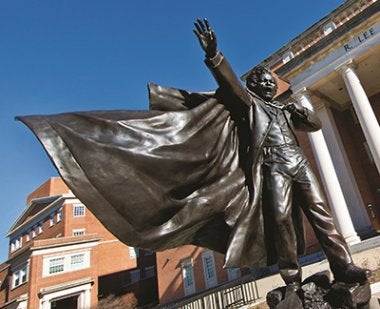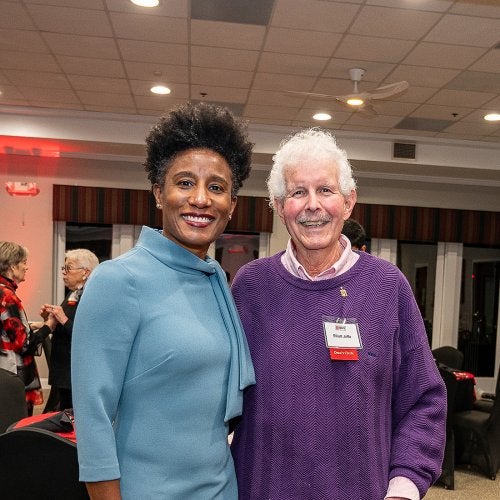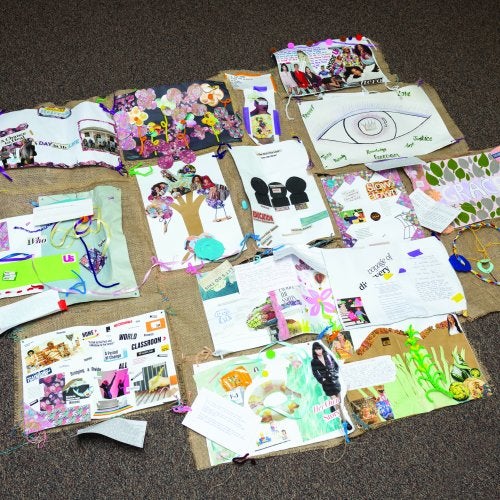
The statue of Frederick Douglass in Hornbake Plaza. Among other inspirations, sculptor Andrew Edwards cites Martín Espadas poem Litany at the Tomb of Frederick Douglass and the cape of Irish nationalist Daniel O'Connell, whom Douglass met during his travels abroad. Photo by John T. Consoli.
In the history of Maryland, Frederick Douglass stands out. Born into slavery, Douglass eventually escaped to become a renowned abolitionist, orator, and writer. Following years of efforts by advocates to have Douglass represented on the campus, the University of Maryland has honored Douglass legacy and work with Frederick Douglass Square, located in front of Hornbake Library.
Douglass was born around 1818 in Talbot County, Maryland. After losing his mother at age 10, Douglass was eventually sent to the home of Hugh Auld in Baltimore. Defying a ban preventing slaves from learning to read and write, Auld’s wife Sophia taught Douglass the alphabet, giving him his first induction into the world of letters. Douglass continued to teach himself how to read and write in secret, becoming an avid reader of newspapers and political writings, which helped define his views on human and civil rights. He became an educator himself, teaching other slaves to read, until he was sent to work for a cruel “slave-breaker” named Edward Covey.
After two failed attempts to escape from slavery, Douglass succeeded on September 3, 1838. With the help of Anna Murray, a woman with whom he had fallen in love, Douglass traveled to New York and eventually settled in Massachusetts. He attended abolitionist meetings and subscribed to William Lloyd Garrison’s journal, The Liberator. Douglass was later asked to share his story at the meetings, which led to his becoming a frequent lecturer. In 1845, Douglass published his first and best-known autobiography, Narrative of the Life of Frederick Douglass, an American Slave. Following the publication, Douglass traveled to England and Ireland to avoid recapture by his former owner, returning to the United States in 1847 to begin publishing his first abolitionist newspaper, The North Star.
During the Civil War period, Douglass was a highly influential speaker on civil and women’s rights. He served as an advisor on the treatment of black soldiers and on black suffrage, respectively, to Presidents Abraham Lincoln and Andrew Johnson. After the war, he served as president of the Freedman’s Savings Bank and worked in international affairs. Douglass remained active until his death on February 20, 1895. He is remembered as a towering figure in the history of abolitionism and American civil rights, as well as an accomplished author.
Last April, the University of Maryland announced its plan to commemorate Frederick Douglass on campus. The commemoration was the result of a five-year effort by the North Stars, a group of campus leaders led by Distinguished University Professor Ira Berlin that worked to secure funding and approve architectural and landscape designs for a memorial. Frederick Douglass Square was constructed over the summer, with funding from the university, private donations, the Maryland Commission on African American History and Culture, and the Maryland Historical Trust.
The official dedication of the memorial was held on November 18, 2015. Situated at the entrance of Hornbake Library, the square features a statue of Douglass as well as paved stones and a corten steel wall with engravings of Douglass’ famous quotations. The corten wall holds planters filled with native Irish and Maryland plants, representing Douglass’ roots in Maryland and his time in Ireland. President Wallace Loh, Dean Bonnie Thornton Dill of the College of Arts and Humanities, and Dr. Berlin all spoke at the event. In attendance were Kenneth B. Morris, Jr., Douglass’ great-great-great-grandson, and Nettie Washington Douglass, the great-great-granddaughter of Douglass and great-granddaughter of Booker T. Washington.
“Frederick Douglass Square was created to teach what Douglass has advocated, as well as what he continues to inspire us to do,” said Dr. Berlin. “We memorialize Frederick Douglass in the center of campus in a space that is both classroom and monument. It is a place to contemplate and celebrate the ideals that Douglass exemplified.”
Douglass’ work is intertwined with the research and curriculum of the university in many ways. UMD Libraries houses an interpretive exhibition, “Frederick Douglas: Scholarship and Legacy,” featuring images and works that provide insight into the abolitionist’s life and legacy. The exhibition showcases three strands of Douglass scholarship at UMD: Mark Leone’s archaeological investigations into Douglass and other enslaved people in Maryland; Ira Berlin’s scholarship on the history of slavery, which situates Douglass as an international human rights leader; and Robert Levine’s cultural and historical scholarship on 19th-century American literature, which illuminates Douglass’ role as a dynamic orator and brilliant writer. The exhibition includes a digital installation featuring Douglass portraits and quotes, as well as archaeological artifacts from the early 19th-century plantation landscape that he remembered as a child.
The memorial corresponds with the University of Maryland’s commitment to honoring individuals who made great strides in the world despite significant social obstacles. In October, the university announced that the Art-Sociology Building would be renamed for the late Parren J. Mitchell, the first African-American to obtain a graduate degree from the university. An activist from a young age, Mitchell applied to the graduate program in sociology at the University of Maryland after serving in the Army, where he received a Purple Heart, and earning a bachelor’s degree from Morgan State University. When the administration wished to bar him from taking classes, the Baltimore City Court ruled that he was to be accepted as a full-time student. Mitchell graduated with honors in 1952 and went on to serve in several academic and public positions before being elected to Congress in 1970.
A daguerreotype of Douglass, ca. 1847-52, by Samuel J. Miller. Art Institute of Chicago.
With these dedications, the University of Maryland honors those who overcome hardships, celebrating the hard work and spirit they bring to the university each day.
To learn more about Frederick Douglass Square, read the November story on the dedication at UMD Right Now.



